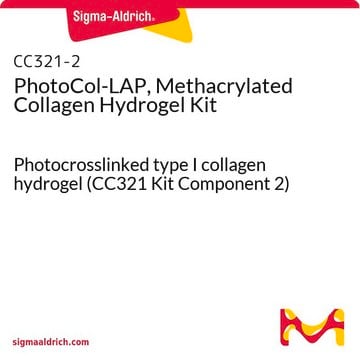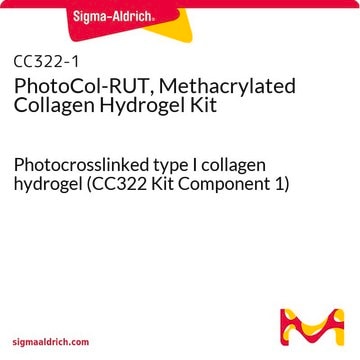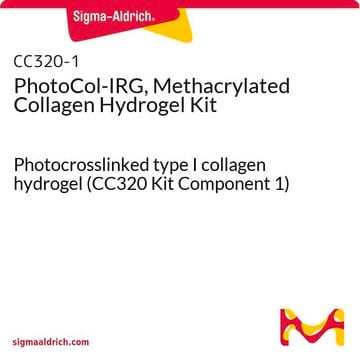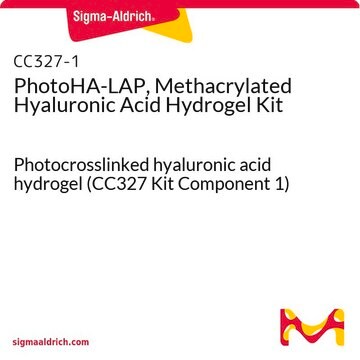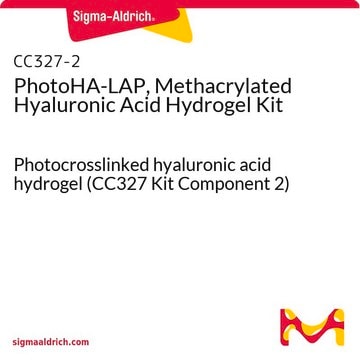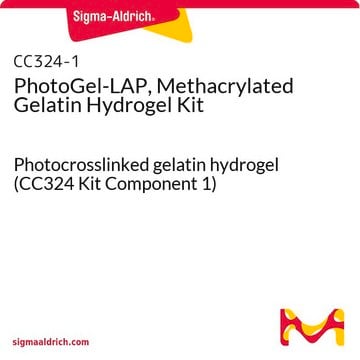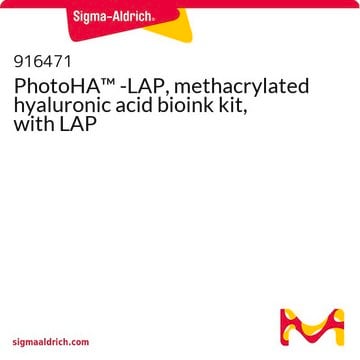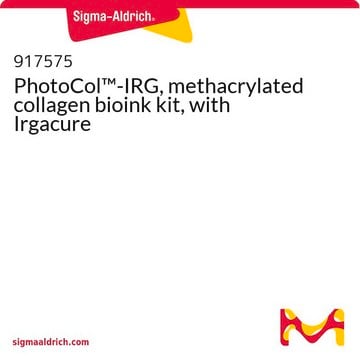The Hydrogel can be hydrolyzed with collagenase for downstream cell studies, such as viability. Optimization of Collagenase concentration is recommended for best dissolution. Please see the link below to review a collagenase product that may be of interest and has been used to digest collagen scaffolds from osteosarcoma cells:
https://www.sigmaaldrich.com/US/en/product/sigma/c8051
CC321-1
PhotoCol-LAP, Methacrylated Collagen Hydrogel Kit
Photocrosslinked type I collagen hydrogel (CC321 Kit Component 1)
Select a Size
About This Item
Recommended Products
application(s)
cell analysis
General description
Application
Packaging
Components
Note: The complete PhotoCol-LAP, Methacrylated Collagen Hydrogel Kit (CC321) consists of CC321-1 and CC321-2 sold seperately.
Quality
Disclaimer
Signal Word
Warning
Hazard Statements
Precautionary Statements
Hazard Classifications
Eye Irrit. 2 - Met. Corr. 1 - Skin Irrit. 2
Storage Class Code
8B - Non-combustible corrosive hazardous materials
Flash Point(F)
Not applicable
Flash Point(C)
Not applicable
Certificates of Analysis (COA)
Search for Certificates of Analysis (COA) by entering the products Lot/Batch Number. Lot and Batch Numbers can be found on a product’s label following the words ‘Lot’ or ‘Batch’.
Already Own This Product?
Find documentation for the products that you have recently purchased in the Document Library.
Articles
Methacrylated hydrogels enable 3D cell culture scaffolds and bioprinting using light crosslinking.
Hydrogela are the most widely used systems for 3D cell culture. Learn more about this technology (what are hydrogels? How to chose?)
-
Is it possible after the bioprinting of the cell-laden hydrogel scaffold, to hydrolise this specific hydrogel to separate and collect the cells from it for checking viability with flow cytometry?
1 answer-
Helpful?
-
-
Sehr geehrte Damen und Herren, Ich wollte fragen wie viel methacryliertes Collagen in dem Gebinde ist, mit welcher Konzentration. Ist es schon in Lösung, wenn ja mit welcher Endkonzentration? Ist es schon mit dem LAP gemischt? Ist das Collagen steril?
1 answer-
This product is a 10 mL bottle of the Neutralization Solution component of a two-part kit - PhotoCol-LAP, Methacrylated Collagen Hydrogel Kit. The Neutralization Solution is comprised of 1 % NaOH in 10x PBS. This item is used in conjunction with the CC321-2, which includes 100 mg of Methacrylated Collagen, 50 mL of a 20 mM Acetic acid solution, and 100 mg of the LAP Photoinitiator.
A full datasheet and protocol may supplied by our Technical Service team, who can assist you further. We kindly ask you to navigate to the link https://www.sigmaaldrich.com/techservice and click on "Product Documentation" under the Products Section with all the required information so that a member of our team can reach out to you to assist further. Thank you.Helpful?
-
Active Filters
Our team of scientists has experience in all areas of research including Life Science, Material Science, Chemical Synthesis, Chromatography, Analytical and many others.
Contact Technical Service